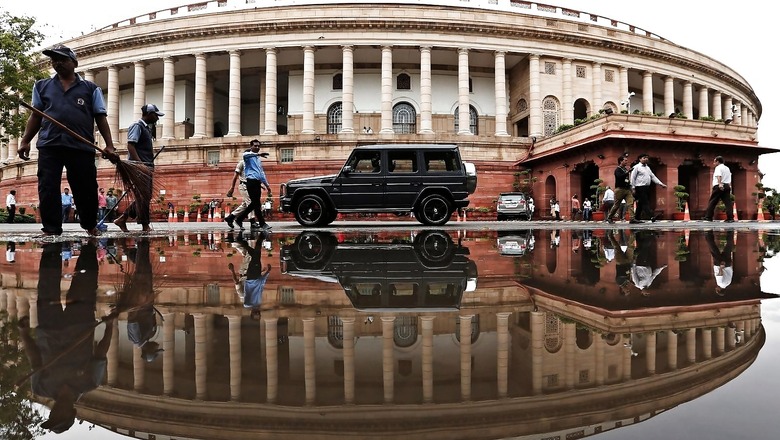
views
Almost every country has some form of parliament and its systems fall into two categories — bicameral and unicameral. Out of a total number of countries in the world, 79 have a bicameral parliamentary system while 113 are unicameral. There are a total of 272 chambers of parliament with over 46,000 members of parliament across the world. The Inter-Parliamentary Union (IPU) which is an international organization of national parliaments has 178 national parliaments as its members.
What is a parliament?
Parliament is a national assembly of elected representatives of the people from across states in a country. It has the authority to enact laws which include adding new laws or changing and abolishing the existing ones. The assembly of elected representatives of the people at the state level is called the legislature or the legislative assembly.
Parliament refers to the national legislature, as per NCERT class 11 political science chapter 5. “Legislature is not merely a law-making body. Lawmaking is but one of the functions of the legislature. It is the center of all democratic political process," the chapter added.
Indian Parliament
The Indian parliament consists of the office of the president and two houses — the Rajya Sabha and the Lok Sabha. It is bicameral by nature. The Rajya Sabha or the Council of States has 245 members and the Lok Sabha or the House of the People together has 543 members. The speaker presides over the sessions of the two houses.
The Constitution has given the states the option of establishing either a unicameral or bicameral legislature. At present, six Indian states have a bicameral legislature — Andhra Pradesh, Bihar, Karnataka, Maharashtra, Telangana, and Uttar Pradesh.
Rajya Sabha
The term of office at the Rajya Sabha is six years. The Vice President is the chairman of the Rajya Sabha. Currently, it is M Venkaiah Naidu. The members of Rajya Sabha are elected by the elected members of the state assembly for a term of six years. They can get re-elected.
All members of the Rajya Sabha do not complete their terms at the same time. About one-third members of the members complete their term every two years. Hence, elections are held for those one-third seats only. This is why the Rajya Sabha is never fully dissolved and is called the permanent house of the parliament.
Apart from the elected members, Rajya Sabha also has 12 nominated members who are nominated by the president. These nominations are made from among those persons who have made their mark in the fields of literature, science, art, and social service.
The functions of the Rajya Sabha are:
— Considers and approves non-money bills and suggests amendments to money bills.
— Approves constitutional amendments.
— Exercises control over executive by asking questions and introducing motions and resolutions.
— Participates in the election and removal of the president, vice president, judges of the Supreme Court, and high courts. Further, it can alone initiate the procedure for the removal of the Vice President.
— Can give the Union parliament power to make laws on matters included in the state list.
Lok Sabha
The Lok Sabha members are directly elected by the people of India for a term of five years. However, before the completion of five years, the Lok Sabha can be dissolved if no party or coalition can form the government or if the Prime Minister advises the president to dissolve the Lok Sabha and hold fresh elections.
Once the Lok Sabha passes the budget, the Rajya Sabha cannot reject it as it is not directly elected by the people. The Lok Sabha’s functions include:
— Making laws on matters included in Union List and Concurrent List. Can introduce and enact money and non-money bills.
— Approves proposals for taxation, budgets, and annual financial statements.
— Controls the executive by asking questions, supplementary questions, resolutions, and motions and through a no-confidence motion.
— Amends the Constitution.
— Approves the Proclamation of emergency.
— Elects the President and Vice President and removes Judges of Supreme Court and High Court.
— Establishes committees and commissions and considers their reports.
How Indian Parliament Makes Law
A bill is a draft of the proposed law. When a non-minister proposes a bill, it is called a private member’s Bill while it is called a government Bill when a minister proposes it. “Within the Parliament, a bill may be introduced in the Lok Sabha or Rajya Sabha by a member of the House (but often a minister responsible for the subject introduces the bill). A money bill can be introduced only in Lok Sabha. Once passed there, it is sent to the Rajya Sabha," reads NCERT.
A bill has to be passed by both houses but if there is disagreement, an attempt is made to resolve it through a Joint Session of Parliament. If it still fails to resolve, the decision goes in favor of the Lok Sabha. If it is a money bill, the Rajya Sabha can either approve the bill or suggest changes but cannot reject it. When a bill is passed by both Houses, it is sent to the President for his assent who then turns it into law.
Countries and their Parliament names
Afghanistan — Shora
Albania — People’s Assembly
Algeria — National People’s Assembly
Andorra — General Council
Angola — National People’s Assembly
Argentina — National Congress
Australia — Federal Parliament
Austria — National Assembly
Azerbaijan — Melli Majlis
Bahamas — General Assembly
Bahrain — Consultative Council
Bangladesh — Jatia Parliament
Belize — National Assembly
Bhutan — Tsogdu
Bolivia — National Congress
Botswana — National Assembly
Brazil — National Congress
Britain — Parliament (House of Commons and House of Lords)
Brunei — National Assembly
Bulgaria — Narodno Sabranie
Cambodia — National Assembly
Canada — Parliament
China — National People’s Assembly
Colombia — Congress
Comoros — Legislative Council and Senate
Congo Democratic — Republic of National Legislative Council
Costa Rice — Legislative Council and Senate
Croatia — Sabor
Cuba — National Assembly of People’s Power
Denmark — Folketing
East Timor — Constituent Assembly
Ecuador — National Congress
Egypt — People’s Assembly
El Salvador — Legislative Assembly
Ethiopia — Federal Council and House of Representative
Fiji Islands — Senate & House of Representative
Finland — Eduskusta (Parliament)
France — National Assembly
Germany — Bundestag (Lower House) and Bundesrat (Upper House)
Great Britain — Parliament
Greece — Chamber of Deputies
Guyana — National Assembly
Hungary — National Assembly
Iceland — Althing
India — Sansad
Indonesia — People’s Consultative Assembly
Iran — Majlis
Iraq — National Assembly
Ireland — Oireachtas
Israel — The Knesset
Italy — Chamber of Deputies and Senate
Japan — Diet
Jordan — National Assembly
Korea (North) — Supreme People’s Assembly
Korea (South) — National Assembly
Kuwait — National Assembly
Lebanon — National Assembly
Laos — People’s Supreme Assembly
Latvia — Saeima
Lesotho — National Assembly and Senate
Libya — General People’s Congress
Lithuania — Seimas
Luxembourg — Chamber of Deputies
Madagascar — National People’s Assembly
Magnolia — Khural
Malaysia — Majilis
Maldives — Majilis
Mongolia — Great People’s Khural
Montenegro — Federal Assembly
Mozambique — People’s Assembly
Myanmar — Pyithu Hluttaw
Nepal — Rashtriya Panchayat
Netherlands — States-General (Staten-General)
New Zealand — Parliament (House of Representative)
Norway — Storting
Oman — Monarchy
Pakistan — National Assembly & Senate
Papua New Guinea — National Parliament
Paraguay — Senate and Chamber of Deputies
Philippines — The Congress
Poland — Sejm
Romania — Great National Assembly
Russia — Duma & Federal Council
Saudi Arabia — Majlis Al-Shura
South Africa — Parliament
Spain — Cortes
Taiwan — Yuan
Turkey — Grand National Assembly
USA — Congress
Uzbekistan — Oliy Majlis
Vietnam — National Assembly
Zambia — National Assembly
Zimbabwe — Parliament
Let’s Test Our Learning
China has the largest parliament with 3,000 members in the Chinese National People’s Congress while the world’s smallest parliament is in Micronesia, with just 14 members of parliament (MPs).
American Parliament: The American parliament or the Congress was established under the Constitution of 1789. It is separated structurally from the executive and judicial branches of government and is bicameral by nature.
Chinese Parliament: Meanwhile, for the Chinese parliament which was formed on October 1, 1949, as per 2018, it has a total of 2980 members thus making it the biggest one in the world.
UK Parliament: The Parliament of the United Kingdom is the first one in the world. It was first convened in 1215 with the creation and signing of the Magna Carta that had established the rights of barons to serve as consultants to the king on matters related to the government in his Great Council. It is the supreme most powerful political bodies in the UK. The UK parliament is bicameral in nature but it has three parts, consisting of the sovereign or the Crown, the House of Lords, and the House of Commons. Both the houses of parliament meet in separate chambers at the Palace of Westminster located in London.
German Parliament: Germany has a bicameral legislature known as — Federal Assembly (Bundestag) and Federal Council (Bundesrat). The former is elected by combining direct and proportional representation for a period of four years. Meanwhile, for council, the 16 federal states of Germany are represented. The members are generally the ministers in the governments at the state level and are appointed.
Read all the Latest Education News here




















Comments
0 comment